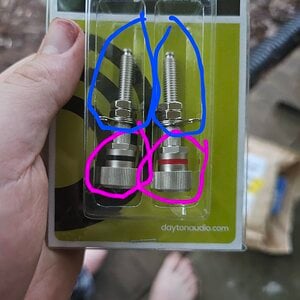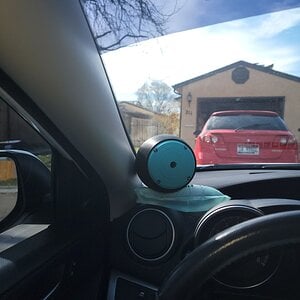20 hz bass machine Premium Member
Danger Ranger
I use BB6 to design subwoofer enclosures. The biggest problem with the program (in my opinion) is the lack of a slot port option. This has you doing all sorts of math going back and forth making changes until everything is right.
BB6 does have a rectangular port option but the program assumes you are building the port straight, and in 4 different pieces (Top, Bottom, sides). In the case of a slot port without a bend, the math to find the actual port displacement is rather easy as the length doesn't change. In the case that you have a slot port with a turn, there are other factors that need to be accounted for and calculating an accurate port displacement is more difficult.
I took it upon myself to do the math and make a "cheat sheet" for calculating proper displacement.
The example I used when building the cheat sheet is as follows:
30" Internal port length
12" Internal height
2" Internal width
1.5" baffle
.75" port wall thickness
3 common walls
1 turn
Inputting the data into bassbox will give you a internal volume of .82 cubes and an overall port length of 31.5" (1.5" added from the baffle)
In reality, the actual displacement is .612 cubes
In short:
BB6 calculated the port displacement 134% larger than the actual port displacement. In contrast, the actual port displacement is 74.6% smaller than BB6's calculated displacement.
Id get into the math on how I arrived at those values but ill spare you the time.
Additionally, when using a slot port with a turn, the actual port length needs to be modified. This is due to the port length being measured from the middle of the port rather than the combined length of the 2 internal port pieces. The calculation for this one is easy.
Inputted internal port length+ baffle thickness+ internal port width.
In our example, an internal port length of 30" would actually be 33.5"
Lastly, if your slot port doesn't have a turn, the length stays the same but the actual displacement % comparison is different.
BB6's displacement stays the same .82 cubes 143% bigger than actual
The actual displacement is .573 cubes 69.9% smaller than BB6's calculated displacement.
In conclusion;
If the software you're using doesn't have a slot port option, you can use the values listed above to calculate actual port displacement and port length from whats provided by the program very quickly.
Hopes this proves helpful to someone.
Thank you.
BB6 does have a rectangular port option but the program assumes you are building the port straight, and in 4 different pieces (Top, Bottom, sides). In the case of a slot port without a bend, the math to find the actual port displacement is rather easy as the length doesn't change. In the case that you have a slot port with a turn, there are other factors that need to be accounted for and calculating an accurate port displacement is more difficult.
I took it upon myself to do the math and make a "cheat sheet" for calculating proper displacement.
The example I used when building the cheat sheet is as follows:
30" Internal port length
12" Internal height
2" Internal width
1.5" baffle
.75" port wall thickness
3 common walls
1 turn
Inputting the data into bassbox will give you a internal volume of .82 cubes and an overall port length of 31.5" (1.5" added from the baffle)
In reality, the actual displacement is .612 cubes
In short:
BB6 calculated the port displacement 134% larger than the actual port displacement. In contrast, the actual port displacement is 74.6% smaller than BB6's calculated displacement.
Id get into the math on how I arrived at those values but ill spare you the time.
Additionally, when using a slot port with a turn, the actual port length needs to be modified. This is due to the port length being measured from the middle of the port rather than the combined length of the 2 internal port pieces. The calculation for this one is easy.
Inputted internal port length+ baffle thickness+ internal port width.
In our example, an internal port length of 30" would actually be 33.5"
Lastly, if your slot port doesn't have a turn, the length stays the same but the actual displacement % comparison is different.
BB6's displacement stays the same .82 cubes 143% bigger than actual
The actual displacement is .573 cubes 69.9% smaller than BB6's calculated displacement.
In conclusion;
If the software you're using doesn't have a slot port option, you can use the values listed above to calculate actual port displacement and port length from whats provided by the program very quickly.
Hopes this proves helpful to someone.
Thank you.


